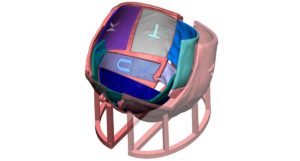3D Systems (NYSE:DDD) announced today the expansion of its groundbreaking Virtual Surgical Planning (VSP®) service to include VSP Cranial for cranial and craniofacial procedures. VSP Cranial is 510(k) cleared for use in the operating room and enables surgeons to create a virtual pre-surgical plan that can be instrumented with sterilizable, patient-specific 3D printed anatomical models, guides and templates. The use of VSP Cranial on these complex and sensitive procedures enables doctors to plan around and become familiar with a patient’s specific anatomy, and is intended to facilitate the pre-surgical planning process as well as the transfer of that plan to the operating room. By supplying surgeons with informative digital tools and accurate 3D printed surgical guides, VSP Cranial is designed to help doctors deliver improved surgical outcomes.

3D Systems VSP® Cranial positioning guides assist the surgeon in creating the optimal cranial shape on the operating table.
3D Systems’ VSP service combines medical image processing, surgical simulation and 3D printing to deliver patient-specific surgical plans under the direction of the presiding doctor. Using patient CT scans, 3D Systems’ engineers extract 3D anatomical data and transform them into 3D images. This information is then used as the foundation for a digital surgical plan, enabling surgeons to better visualize the upcoming procedure. In an online meeting with the surgeon, 3D Systems’ engineers assist the surgical team in creating a virtual surgical plan in which a range of age matched normative data can be digitally overlaid to help establish a normal reference contour for these challenging patients. Based on the plan, patient-specific tools including marking guides, positioning guides, and anatomical models can be 3D printed using 3D Systems’ stereolithography (SLA) printers in white and clear materials with selective coloration options for distinguishing critical structures such as vasculature and nerves.
The VSP Cranial service is designed to support a variety of craniofacial cases, especially those requiring cranial vault distraction and procedures related to craniosynostosis. Craniosynostosis occurs in one of every 2,000 births, and is a condition in which one or more of the fibrous sutures in an infant’s skull prematurely fuses and turns into bone, causing a change in the skull’s growth pattern. In some cases, the resulting growth pattern allows enough space for the growing brain, but causes an abnormal head shape and abnormal facial features (1). In other cases, the growing brain does not have enough room, leading to increased intracranial pressure which can cause visual impairment, sleeping impairment, eating difficulties, or impaired mental development and a significantly reduced IQ (2). By intervening surgically, doctors seek to enable normal cranial vault development by normalizing the calvarial shape. If craniosynostosis is left untreated, the deformity progressively worsens, threatening both aesthetic and functional outcomes for these patients (3).
“As someone who has routinely used VSP for over five years, I have quickly adopted cranial applications into my practice,” said Dr. Oren Tepper, Director of Aesthetic Surgery, Montefiore Health System and Assistant Professor of Plastic Surgery, Albert Einstein College of Medicine. “Fortunately, my neurosurgery colleagues also recognize the clinical value of VSP Cranial, and this technology now plays an integral role in many of our combined intracranial cases. 3D Systems’ engineers make the process seamless, especially for physicians who may be less familiar with these applications.
“The addition of VSP Cranial affords surgeons the ability to visualize and pre-plan complex cranial reconstructive surgeries that may not have been possible previously,” said Kevin McAlea, EVP, General Manager, Metals and Healthcare, 3D Systems. “3D Systems is committed to expanding our solutions to support the most advanced patient care available.”
References:
(1) Slater BJ, Lenton KA, Kwan MD, Gupta DM, Wan DC, Longaker MT. „Cranial sutures: a brief review”. Plast. Reconstr. Surg. 121 (4) (April 2008): 170e–8e.
(2) Gault DT, Renier D, Marchac D, Jones BM. „Intracranial pressure and intracranial volume in children with craniosynostosis”. Plast. Reconstr. Surg. 90 (3) (September 1992): 377–81.
(3) Panchal J, Uttchin V. „Management of craniosynostosis”. Plast. Reconstr. Surg. 111 (6) (May 2003): 2032–48; quiz 2049.
About 3D Systems
3D Systems provides comprehensive 3D products and services, including 3D printers, print materials, on demand manufacturing services and digital design tools. Its ecosystem supports advanced applications from the product design shop to the factory floor to the operating room. 3D Systems’ precision healthcare capabilities include simulation, Virtual Surgical Planning, and printing of medical and dental devices as well as patient-specific surgical instruments. As the originator of 3D printing and a shaper of future 3D solutions, 3D Systems has spent its 30 year history enabling professionals and companies to optimize their designs, transform their workflows, bring innovative products to market and drive new business models.
More information on the company is available at www.3dsystems.com
Source: 3D Systems